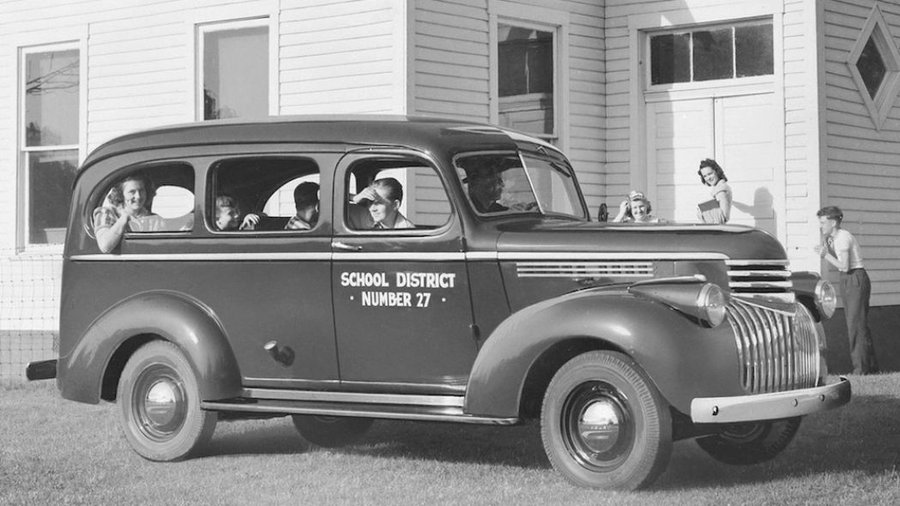How the World's Oldest Auto Nameplate Aged in Eight Decades

No, really, it really is the industry's longest continuous car name in production, and it all started in 1934 with the Carryall Suburban.
Initially, the Suburban name wasn't a proprietary Chevy name and it was also used by Dodge, DeSoto, Studebaker, Nash and Plymouth. It was essentially used to describe a specific body style, a windowed version of a usually commercial vehicle for carrying passengers.
At first, the Suburban was a station wagon placed atop a small truck frame, but over the years it's also grown in height (as well as length) and nowadays we associate the nameplate with a big full-size SUV which technically is more of a closed bed version of a GM pickup.
It's gone through no fewer than twelve generations over the decades, yet it always remained a firm favorite with buyers. In 1967, it was upgraded to an extended chassis (and from then on it was not available in shorter wheelbase variants) so that it didn't affect sales of the newly introduced (and smaller) K5 Blazer.
The first-gen, the Suburban Carryall, built from 1935 to 1940, was a two-door vehicle built on a half-ton chassis. It was powered by a 60 horsepower straight-six (that was later upped to 79 horsepower) and it's actually considered a looker today, with its Art Deco design elements and streamlined aesthetic.
The streamlined look was accentuated even more for the second-gen model (1941 to 1946) which also increased in size somewhat and also received a bigger 3.7-liter engine. The third-gen model (1947 to 1954) adopted what we'd now call the 50s look, but it didn't bring any significant changes to the formula.
More radical changes were in store for the fourth-gen model (1955 to 1959). In fact, this model is considered the "second series," or, in other words, the first all-new model since the original was introduced. You can most easily spot one of these by its wrap-around windscreen which was a first for the model, yet it's mechanical enhancements that made it stand out - it was the first Suburban to get both V8 engine options, as well as all-wheel drive.
For the fifth-generation (1960 to 1966), Chevrolet at first went for a bold style that harkened back to the look of the early 50s Suburban. However, this was changed after 1962 when a considerably more conservative design was adopted. Next up came the sixth-gen Suburban which is remembered for having one door on the driver's side and two doors on the passenger's side - this is definitely where Hyundai got the inspiration from for the its Veloster model.
The seventh-gen model is the first four-door Suburban ever. Its shape is also the most recognizably Suburban too - it had a flat, rectangular fascia, with rectangular headlight clusters and a rectangular grille. For the eighth-gen Suburban (1992 to 1999), the design became more rounded and slightly more friendly looking (both inside and out), and it was also made more car-like to drive.
Believe it or not, the tenth-gen Suburban (2007 to 2014) actually featured a wind tunnel-honed shape that ditched the traditional chrome bumpers (in favor of more streamlined, flush-mounted bumpers that were devoid of chrome), and it was also infused with tech like hill start assist and blind spot warning.
Now the vehicle is in its eleventh generation and it's business as usual. The same basic formula (a long-wheelbase, full-size SUV), but now made more refined and bristling with more tech than ever. It's probably this dramatic increase in the number of electronics and gadgets that sets the latest Suburban apart. That and its very bold front fascia that looks like it's a two-story high pavilion that celebrates all things chrome.
There are still many post-seventh-gen Suburbans still on the road, since many found homes as family haulers and because they were quite reliable, many families never needed to trade them in. The Suburban was also used by the police and army, and even private security firms got in on the action - since the model began to be associated with law enforcement and its presence exuded some kind of authority.
The Suburban was a firm favorite of rappers in the 1990s. It's used to be mentioned and prominently featured in their music and videos, although, in more recent years, most have moved to the more posh Cadillac Escalade (which, by the way, is essentially the same vehicle but with a luxury makeover).
Paul Edwards, Chevrolet marketing vice president explains that " while the world has changed significantly, the Suburban is just as relevant today as it was in 1935. Suburban created the sport utility vehicle. " That's certainly true, although it's by no means the only vehicle of its type that lead to the modern SUV deluge of biblical proportions.
Related News


